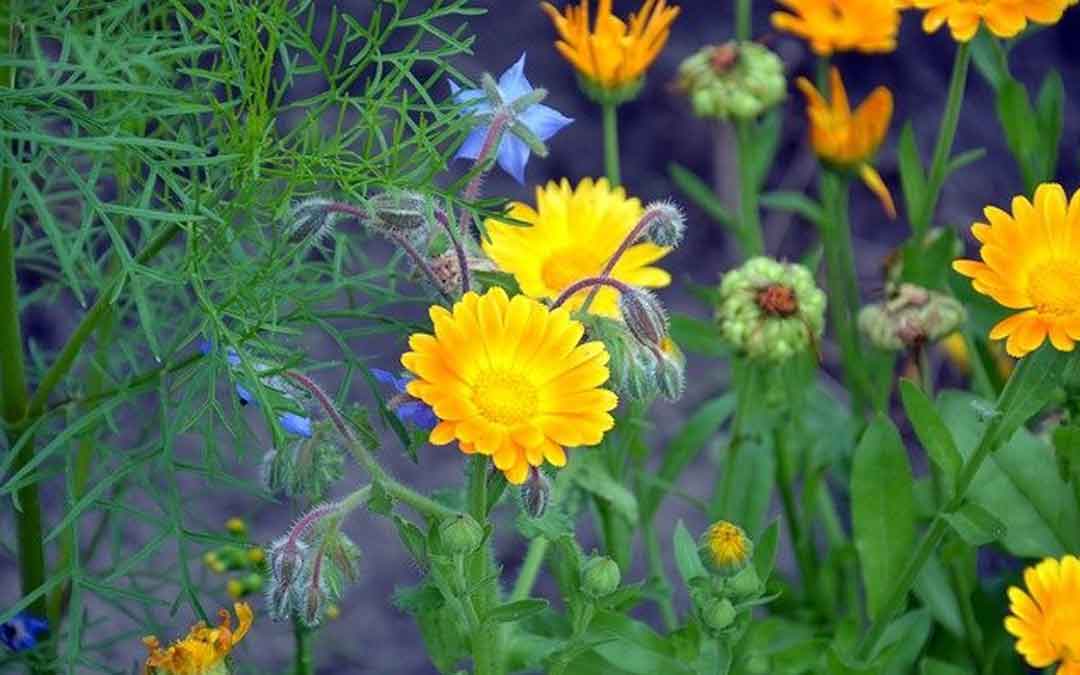Biodiverse planting for pest control in the orchard and vegie garden

One of the best strategies for preventing insect attack in the fruit and vegie garden is to plant a wide array of flowering plants that attract beneficial insects. Beneficial insects are great at disposing of ‘bad bugs’, usually defined as sap sucking or leaf chewing insects (though to be fair to them they often also have beneficial functions in our gardens, such as breaking down plant matter for compost).
Beneficial insects include ladybugs, hoverflies, spiders, praying mantises, lacewings and parasitic wasps. They prey on aphids, mites, whitefly, ants, mealybugs, scale, thrip, caterpillars and earwigs among others. Beneficial insects can polish these off at both the egg and soft bodied stages of their development, thus saving our precious fruit and vegies from demolition and providing protein for these ‘good bugs’.
Beneficial insects need food sources (nectar and protein) and conducive habitat to thrive and to support them in large numbers. This won’t happen by itself. It means planting flowers to which they are particularly attracted. Unlike bees, beneficial insects do not have mouths that can extract nectar from deep within flowers. They need small flowers or larger flowers made up of many smaller flowers. The Compositae family, commonly known as the daisy family, or plants from the Umbelliferae family (also known as the Apiacaea) family which have flower and seed heads shaped like umbrellas, are ideal. The latter includes coriander, chervil, dill, fennel, parsley, carrot, angelica and Queen Anne’s Lace.
In the vegie patch, under your fruit trees or in your orchard, plant as many varieties of flower as you can, including as many white, yellow, or white and yellow blooms as these in particular attract ‘good bugs’. The blues and mauves are excellent too.
Suitable plants are flowering chamomiles, feverfew, daisies, sunflower, cosmos, alyssum, borage, marigold, coneflower, cornflower, goldenrod, catmint, catnip, comfrey, wormwood, sweet marjoram and savoury marjoram, oregano, the savouries, thymes and matting thymes, calendula, rosemary, lavender, coriander, chervil, dill, fennel, angelica, chives and garlic chives and ornamental chive varieties – all of which have smallish or open flowers or are made up of a composite of many small flowers, easily accessible to beneficial insects for the collection of nectar. Plant a range that will flower at different times of the year including winter, and intersperse them throughout the vegie garden, under fruit trees or throughout the orchard.
In the orchard or under fruit trees, there are added complications in relation to planting. It is better not to plant close to the trunk as this area needs to be free so that fallen fruit infested with Queensland fruit fly or codling moth can be removed, and chooks, if you have them, can peck out pupae of these pests from the soil. Alternatively, you can cultivate beneath the tree to remove the pupae.
In an orchard, it is a good idea to plant in a grid pattern with a tree in the centre of each square. If you have chooks, plant densely inside wire frames* between trees to keep the chooks off any seed and seedlings while the plants establish. To avoid bare patches, don’t prepare all the soil at once – once an area has established, move onto another one, ideally with flowers that will bloom later in the season. If you have leaf litter that has not broken down or is slow to break down, under your fruit trees, mow it as it needs to decompose before spring to prevent it harbouring fungi and diseases.
And lastly, supply some water sources for these exceptional, hard working insects.
* Rolling a cylinder of chicken wire is an easy and cheap way of protecting your emerging plants.
Written by Robin Gale-Baker
